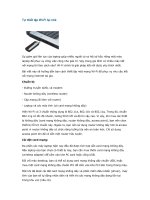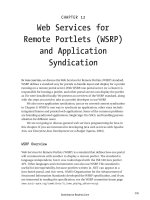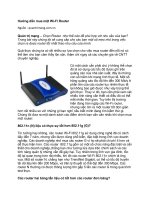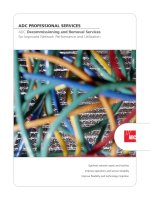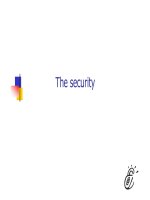mimo ofdm for lte wi fi and wimax coherent versus non coherent and cooperative turbo transceivers ebook 2011 note
Bạn đang xem bản rút gọn của tài liệu. Xem và tải ngay bản đầy đủ của tài liệu tại đây (7.87 MB, 694 trang )
MIMO-OFDM for LTE, Wi-Fi and WiMAX
MIMO-OFDM for LTE, Wi-Fi
and WiMAX
Coherent versus Non-coherent and
Cooperative Turbo-transceivers
Prof. Lajos Hanzo, Dr. Yosef (Jos) Akhtman and Dr. Li Wang
All of
University of Southampton, UK
Dr. Ming Jiang
Currently with
New Postcom Equipment Co., Ltd
A
J
ohn Wile
y
and Sons, Ltd, Publication
This edition first published 2011
c
2011 John Wiley & Sons Ltd
Registered office
John Wiley & Sons Ltd, The Atrium, Southern Gate, Chichester, West Sussex, PO19 8SQ,
United Kingdom
For details of our global editorial offices, for customer services and for information about how to apply
for permission to reuse the copyright material in this book please see our website at www.wiley.com.
The right of the author to be identified as the author of this work has been asserted in accordance with
the Copyright, Designs and Patents Act 1988.
All rights reserved. No part of this publication may be reproduced, stored in a retrieval system, or
transmitted, in any form or by any means, electronic, mechanical, photocopying, recording or
otherwise, except as permitted by the UK Copyright, Designs and Patents Act 1988, without the prior
permission of the publisher.
Wiley also publishes its books in a variety of electronic formats. Some content that appears in print
may not be available in electronic books.
Designations used by companies to distinguish their products are often claimed as trademarks. All
brand names and product names used in this book are trade names, service marks, trademarks or
registered trademarks of their respective owners. The publisher is not associated with any product or
vendor mentioned in this book. This publication is designed to provide accurate and authoritative
information in regard to the subject matter covered. It is sold on the understanding that the publisher is
not engaged in rendering professional services. If professional advice or other expert assistance is
required, the services of a competent professional should be sought.
Library of Congress Cataloging-in-Publication Data
Hanzo, Lajos, 1952–
MIMO-OFDM for LTE, WiFi, and WiMAX : coherent versus non-coherent and cooperative
turbo-transceivers / by L. Hanzo, J. Akhtman, L. Wang, M. Jiang.
p. cm.
Includes bibliographical references and index.
ISBN 978-0-470-68669-0 (cloth)
1. Orthogonal frequency division multiplexing. 2. MIMO systems. 3. Wireless LANs–Equipment and
supplies. 4. IEEE 802.11 (Standard). 5. IEEE 802.16 (Standard) 6. Radio–Transmitter-receivers. I.
Akhtman, J. (Jos) II. Wang, L. (Li), 1982- III. Title.
TK5103.484.H36 2010
621.382’16–dc22
2010015324
A catalogue record for this book is available from the British Library.
Print ISBN: 9780470686690 (H/B)
Set in 9/11pt Times by Sunrise Setting Ltd, Torquay, UK.
We dedicate this monograph to the numerous contributors to this field, many of whom are listed in the
Author Index.
The MIMO capacity theoretically increases linearly with the number of transmit antennas, provided
that the number of receive antennas is equal to the number of transmit antennas. With the further
proviso that the total transmit power is increased proportionately to the number of transmit antennas,
a linear capacity increase is achieved on increasing the transmit power. However, under realistic
conditions the theoretical MIMO-OFDM performance erodes, hence, to circumvent this degradation,
our monograph is dedicated to the design of practical coherent, non-coherent and cooperative
MIMO-OFDM turbo-transceivers .
Contents
About the Authors xix
Other Wiley–IEEE Press Books on Related Topics xxi
Preface xxiii
Acknowledgments xxvii
List of Symbols xxix
1 Introduction to OFDM and MIMO-OFDM 1
1.1 OFDMHistory 1
1.1.1 MIMO-AssistedOFDM 2
1.1.1.1 TheBenefitsofMIMOs 2
1.1.1.2 MIMO-OFDM 5
1.1.1.3 SDMA-basedMIMO-OFDMSystems 6
1.2 OFDMSchematic 9
1.3 Channel Estimation for Multi-carrier Systems 12
1.4 ChannelEstimationforMIMO-OFDM 15
1.5 SignalDetectioninMIMO-OFDMSystems 16
1.6 IterativeSignalProcessingforSDM-OFDM 21
1.7 SystemModel 22
1.7.1 ChannelStatistics 22
1.7.2 RealisticChannelProperties 25
1.7.3 BaselineScenarioCharacteristics 26
1.7.4 MCTransceiver 27
1.8 SDM-OFDMSystemModel 29
1.8.1 MIMOChannelModel 29
1.8.2 ChannelCapacity 30
1.8.3 SDM-OFDMTransceiverStructure 31
1.9 Novel Aspects and Outline of the Book 33
1.10 ChapterSummary 36
2 OFDM Standards 37
2.1 Wi-Fi 37
2.1.1 IEEE 802.11 Standards . . . 38
viii Contents
2.2 3GPPLTE 38
2.3 WiMAXEvolution 39
2.3.1 Historic Background 41
2.3.1.1 IEEE 802.16 Standard Family 41
2.3.1.2 Early 802.16 Standards . 41
2.3.1.2.1 IEEE 802.16d-2004 – Fixed WiMAX 43
2.3.1.2.2 IEEE 802.16e-2005 – Mobile WiMAX 43
2.3.1.2.3 Other 802.16 Standards 45
2.3.1.3 WiMAXForum 46
2.3.1.4 WiMAXandWiBro 47
2.3.2 TechnicalAspectsofWiMAX 47
2.3.2.1 WiMAX-I: 802.16-2004 and 802.16e-2005 . . . 48
2.3.2.1.1 OFDMASystemConfiguration 48
2.3.2.1.2 FrameStructure 48
2.3.2.1.3 SubcarrierMapping 49
2.3.2.1.4 ChannelCoding 50
2.3.2.1.5 MIMO Support 50
2.3.2.1.6 OtherAspects 52
2.3.2.2 WiMAX-II: 802.16m . . 52
2.3.2.2.1 SystemRequirements 52
2.3.2.2.2 SystemDescription 54
2.3.3 TheFutureofWiMAX 58
2.4 ChapterSummary 59
Part I Coherently Detected SDMA-OFDM Systems 61
3 Channel Coding Assisted STBC-OFDM Systems 63
3.1 Introduction . . . 63
3.2 Space–Time Block Codes 63
3.2.1 Alamouti’s G
2
STBC 64
3.2.2 EncodingAlgorithm 66
3.2.2.1 TransmissionMatrix 66
3.2.2.2 Encoding Algorithm of the STBC G
2
66
3.2.2.3 OtherSTBCs 66
3.2.3 DecodingAlgorithm 67
3.2.3.1 Maximum Likelihood Decoding 67
3.2.3.2 Maximum-A-PosterioriDecoding 68
3.2.4 SystemOverview 70
3.2.5 SimulationResults 70
3.2.5.1 PerformanceoverUncorrelatedRayleighFadingChannels 71
3.2.5.2 PerformanceoverCorrelatedRayleighFadingChannel 73
3.2.6 Conclusions 75
3.3 Channel-CodedSTBCs 75
3.3.1 STBCswithLDPCChannelCodes 76
3.3.1.1 SystemOverview 77
3.3.1.2 SimulationResults 78
3.3.1.2.1 Performance over Uncorrelated Rayleigh Fading
Channels 79
3.3.1.2.2 Performance over Correlated Rayleigh Fading Channels . 82
3.3.1.3 ComplexityIssues 86
3.3.1.4 Conclusions 90
Contents ix
3.3.2 LDPC-AidedandTC-AidedSTBCs 90
3.3.2.1 SystemOverview 91
3.3.2.2 ComplexityIssues 91
3.3.2.3 SimulationResults 92
3.3.2.4 Conclusions 93
3.4 ChannelCodingAidedSTBC-OFDM 95
3.4.1 CM-AssistedSTBCs 95
3.4.1.1 CMPrinciples 96
3.4.1.2 Inter-symbolInterferenceandOFDMBasics 96
3.4.1.3 SystemOverview 97
3.4.1.3.1 ComplexityIssues 98
3.4.1.3.2 ChannelModel 98
3.4.1.3.3 Assumptions 98
3.4.1.4 SimulationResults 100
3.4.1.5 Conclusions 102
3.4.2 CM-AidedandLDPC-AidedSTBC-OFDMSchemes 103
3.4.2.1 SystemOverview 104
3.4.2.2 SimulationResults 105
3.4.2.3 Conclusions 106
3.5 ChapterSummary 106
4 Coded Modulation Assisted Multi-user SDMA-OFDM Using Frequency-Domain
Spreading 109
4.1 Introduction 109
4.2 SystemModel 110
4.2.1 SDMAMIMOChannelModel 110
4.2.2 CM-AssistedSDMA-OFDMUsingFrequency-DomainSpreading 111
4.2.2.1 MMSEMUD 111
4.2.2.2 Subcarrier-BasedWHTS 112
4.3 SimulationResults 113
4.3.1 MMSE-SDMA-OFDMUsingWHTS 114
4.3.2 CM-andWHTS-assistedMMSE-SDMA-OFDM 115
4.3.2.1 PerformanceovertheSWATMChannel 115
4.3.2.1.1 Two Receiver Antenna Elements 116
4.3.2.1.2 Four Receiver Antenna Elements 119
4.3.2.2 PerformanceovertheCOST207HTChannel 119
4.3.2.2.1 Two Receiver Antenna Elements 120
4.3.2.2.2 Four Receiver Antenna Elements 126
4.3.2.2.3 PerformanceComparisons 127
4.3.2.3 EffectsoftheWHTBlockSize 132
4.3.2.4 Effects of the Doppler Frequency 133
4.4 ChapterSummary 135
5 Hybrid Multi-user Detection for SDMA-OFDM Systems 139
5.1 Introduction 139
5.2 GA-AssistedMUD 140
5.2.1 SystemOverview 140
5.2.2 MMSE-GA-concatenatedMUD 141
5.2.2.1 OptimizationMetricfortheGAMUD 141
5.2.2.2 ConcatenatedMMSE-GAMUD 142
5.2.3 SimulationResults 144
x Contents
5.2.4 ComplexityAnalysis 146
5.2.5 Conclusions 147
5.3 EnhancedGA-basedMUD 148
5.3.1 ImprovedMutationScheme 148
5.3.1.1 ConventionalUniformMutation 148
5.3.1.2 Biased Q-function-BasedMutation 149
5.3.1.2.1 Theoretical Foundations 150
5.3.1.2.2 SimplifiedBQM 152
5.3.1.3 SimulationResults 153
5.3.1.3.1 BQMVersusUM 153
5.3.1.3.2 BQMVersusCNUM 155
5.3.2 IterativeMUDFramework 155
5.3.2.1 MMSE-Initialized Iterative GA MUD 155
5.3.2.2 SimulationResults 156
5.3.2.2.1 Performance in Underloaded and Fully Loaded Scenarios 158
5.3.2.2.1.1 BQM-IGAPerformance 159
5.3.2.2.1.2 Effects of the Number of IGA MUD
Iterations 160
5.3.2.2.1.3 EffectsoftheUserLoad 161
5.3.2.2.2 PerformanceinOverloadedScenarios 161
5.3.2.2.2.1 OverloadedBQM-IGA 162
5.3.2.2.2.2 BQMVersusCNUM 164
5.3.2.2.3 Performance under Imperfect Channel Estimation 164
5.3.3 ComplexityAnalysis 165
5.3.4 Conclusions 168
5.4 ChapterSummary 168
6 Direct-Sequence Spreading and Slow Subcarrier-Hopping Aided Multi-user
SDMA-OFDM Systems 171
6.1 ConventionalSDMA-OFDMSystems 171
6.2 Introduction to Hybrid SDMA-OFDM . . 172
6.3 Subband Hopping Versus Subcarrier Hopping 173
6.4 SystemArchitecture 175
6.4.1 SystemOverview 175
6.4.1.1 Transmitter Structure . . 176
6.4.1.2 Receiver Structure . . . 178
6.4.2 Subcarrier-Hopping Strategy Design 178
6.4.2.1 Random SSCH 180
6.4.2.2 UniformSSCH 180
6.4.2.2.1 DesignoftheUSSCHPattern 180
6.4.2.2.2 Discussions 183
6.4.2.3 Random and Uniform SFH 184
6.4.2.4 OfflinePatternPre-computation 184
6.4.3 DSSDespreadingandSSCHDemapping 184
6.4.4 MUD 186
6.5 SimulationResults 188
6.5.1 MMSE-AidedVersusMMSE-IGA-AidedDSS/SSCHSDMA-OFDM 190
6.5.2 SDMA-OFDMUsingSFHandHybridDSS/SSCHTechniques 191
6.5.2.1 ModeratelyOverloadedScenarios 191
6.5.2.2 HighlyOverloadedScenarios 192
6.5.3 Performance Enhancements by Increasing Receiver Diversity 194
6.5.4 Performance under Imperfect Channel Estimation 196
Contents xi
6.6 ComplexityIssues 196
6.7 Conclusions 197
6.8 ChapterSummary 197
7 Channel Estimation for OFDM and MC-CDMA 201
7.1 Pilot-AssistedChannelEstimation 201
7.2 Decision-DirectedChannelEstimation 202
7.3 APosterioriFD-CTFEstimation 203
7.3.1 Least-SquaresCTFEstimator 203
7.3.2 MMSECTFEstimator 204
7.3.3 APrioriPredicted-Value-AidedCTFEstimator 206
7.4 APosterioriCIREstimation 206
7.4.1 MMSESS-CIREstimator 206
7.4.2 Reduced-ComplexitySS-CIREstimator 207
7.4.3 ComplexityStudy 210
7.4.4 MMSEFS-CIREstimator 210
7.4.5 PerformanceAnalysis 211
7.4.5.1 RC-MMSESS-CIREstimatorPerformance 213
7.4.5.2 Fractionally Spaced CIR Estimator Performance 214
7.5 ParametricFS-CIREstimation 216
7.5.1 ProjectionApproximationSubspaceTracking 216
7.5.2 DeflationPAST 220
7.5.3 PAST
D-AidedFS-CIREstimation 220
7.6 Time-DomainAPrioriCIRTapPrediction 223
7.6.1 MMSEPredictor 224
7.6.2 RobustPredictor 225
7.6.3 MMSEVersusRobustPredictorPerformanceComparison 226
7.6.4 AdaptiveRLSPredictor 227
7.6.5 RobustVersusAdaptivePredictorPerformanceComparison 229
7.7 PAST
D-AidedDDCE 230
7.8 ChannelEstimationforMIMO-OFDM 233
7.8.1 SoftRecursiveMIMO-CTFEstimation 233
7.8.1.1 LMSMIMO-CTFEstimator 233
7.8.1.2 RLSMIMO-CTFEstimator 236
7.8.1.3 Soft-Feedback-AidedRLSMIMO-CTFEstimator 236
7.8.1.4 ModifiedRLSMIMO-CTFEstimator 237
7.8.1.5 MIMO-CTFEstimatorPerformanceAnalysis 238
7.8.2 PAST
D-AidedDDCEforMIMO-OFDM 240
7.8.2.1 PAST
D-AidedMIMO-DDCEPerformanceAnalysis 240
7.9 ChapterSummary 245
8 Iterative Joint Channel Estimation and MUD for SDMA-OFDM Systems 247
8.1 Introduction 247
8.2 SystemOverview 249
8.3 GA-AssistedIterativeJointChannelEstimationandMUD 250
8.3.1 Pilot-Aided Initial Channel Estimation 252
8.3.2 Generating Initial Symbol Estimates 253
8.3.3 GA-AidedJointOptimizationProvidingSoftOutputs 255
8.3.3.1 ExtendedGAIndividualStructure 255
8.3.3.2 Initialization . . . 255
8.3.3.3 JointGeneticOptimization 256
xii Contents
8.3.3.3.1 Cross-overOperator 256
8.3.3.3.2 MutationOperator 257
8.3.3.3.3 CommentsontheJointOptimizationProcess 257
8.3.3.4 GeneratingtheGA’sSoftOutputs 258
8.4 SimulationResults 259
8.4.1 EffectsoftheMaximumMutationStepSize 260
8.4.2 Effects of the Doppler Frequency . 262
8.4.3 EffectsoftheNumberofGA-JCEMUDIterations 263
8.4.4 EffectsofthePilotOverhead 263
8.4.5 JointOptimizationVersusSeparateOptimization 263
8.4.6 ComparisonofGA-JCEMUDsHavingSoftandHardOutputs 265
8.4.7 MIMORobustness 265
8.5 Conclusions 268
8.6 ChapterSummary 268
Part II Coherent versus Non-coherent and Cooperative OFDM
Systems 271
List of Symbols in Part II 273
9 Reduced-Complexity Sphere Detection for Uncoded SDMA-OFDM Systems 275
9.1 Introduction . . . 275
9.1.1 SystemModel 275
9.1.2 Maximum Likelihood Detection . 276
9.1.3 Chapter Contributions and Outline 278
9.2 PrincipleofSD 278
9.2.1 TransformationoftheMLMetric 278
9.2.2 Depth-FirstTreeSearch 279
9.2.3 Breadth-FirstTreeSearch 283
9.2.4 GeneralizedSphereDetection(GSD)forRank-DeficientSystems 284
9.2.4.1 GSD 284
9.2.4.2 GSDUsingaModifiedGrammianMatrix 284
9.2.5 SimulationResults 285
9.3 Complexity-ReductionSchemesforSD 289
9.3.1 Complexity-ReductionSchemesforDepth-FirstSD 289
9.3.1.1 ISRSelectionOptimization 289
9.3.1.2 OptimalDetectionOrdering 290
9.3.1.3 SearchAlgorithmOptimization 291
9.3.1.3.1 SortedSphereDetection(SSD) 291
9.3.1.3.2 SSD Using Updated Bounds 292
9.3.1.3.3 SSDUsingTerminationThreshold 293
9.3.2 Complexity-Reduction Schemes for K-BestSD 294
9.3.2.1 OptimalDetectionOrdering 294
9.3.2.2 Search-Radius-Aided K-BestSD 295
9.3.2.3 Complexity-Reduction Parameter δ forLowSNRs 296
9.3.3 OHRSA–AnAdvancedExtensionofSD 297
9.3.3.1 HierarchicalSearchStructure 297
9.3.3.2 Optimization Strategies for the OHRSA Versus Complexity-Reduction
TechniquesfortheDepth-FirstSD 299
9.3.3.2.1 Best-FirstDetectionStrategy 299
Contents xiii
9.3.3.2.2 SortingCriterion 299
9.3.3.2.3 LocalTerminationThreshold 300
9.3.3.2.4 PerformanceEvaluation 301
9.4 Comparison of the Depth-First, K-BestandOHRSADetectors 301
9.4.1 Full-RankSystems 301
9.4.2 Rank-DeficientSystems 302
9.5 ChapterConclusions 303
10 Reduced-Complexity Iterative Sphere Detection for Channel-Coded SDMA-OFDM
Systems 307
10.1 Introduction 307
10.1.1 Iterative Detection and Decoding Fundamentals . . 307
10.1.1.1 SystemModel 307
10.1.1.2 MAPBitDetection 308
10.1.2 Chapter Contributions and Outline 310
10.2 Channel-CodedIterativeCentre-ShiftingSD 311
10.2.1 GenerationoftheCandidateList 311
10.2.1.1 ListGenerationandExtrinsicLLRCalculation 311
10.2.1.2 ComputationalComplexityofLSDs 312
10.2.1.3 SimulationResultsand2DEXIT-ChartAnalysis 313
10.2.2 Centre-ShiftingTheoryforSDs 316
10.2.3 Centre-Shifting K-Best SD-Aided Iterative Receiver Architectures 318
10.2.3.1 Direct Hard-Decision Centre-Update-Based Two-Stage Iterative
Architecture 319
10.2.3.1.1 Receiver Architecture and EXIT-Chart-Aided Analysis . 319
10.2.3.1.2SimulationResults 322
10.2.3.2 Two-Stage Iterative Architecture Using a Direct Soft-Decision
CentreUpdate 324
10.2.3.2.1Soft-SymbolCalculation 325
10.2.3.2.2 Receiver Architecture and EXIT-Chart-Aided Analysis . 326
10.2.3.2.3SimulationResults 328
10.2.3.3 Two-Stage Iterative Architecture Using an Iterative
SIC-MMSE-AidedCentreUpdate 328
10.2.3.3.1SIC-AidedMMSEAlgorithm 329
10.2.3.3.2 Receiver Architecture and EXIT-Chart Analysis 330
10.2.3.3.3SimulationResults 331
10.3 APrioriLLR-Threshold-AssistedLow-ComplexitySD 334
10.3.1 PrincipleoftheALT-AidedDetector 334
10.3.2 Features of the ALT-Assisted K-Best SD Receiver . 335
10.3.2.1 BERPerformanceGain 335
10.3.2.2 ComputationalComplexity 336
10.3.2.3 ChoiceofLLRThreshold 338
10.3.2.4 Non-Gaussian-Distributed LLRs Caused by the ALT Scheme . . . . 339
10.3.3 ALT-AssistedCentre-ShiftingHybridSD 341
10.3.3.1 ComparisonoftheCentre-ShiftingandtheALTSchemes 341
10.3.3.2 ALT-AssistedCentre-ShiftingHybridSD 342
10.4 URC-Aided Three-Stage Iterative Receiver Employing SD 343
10.4.1 URC-Aided Three-Stage Iterative Receiver 343
10.4.2 Performance of the Three-Stage Receiver Employing the Centre-Shifting SD . 348
10.4.3 Irregular Convolutional Codes for Three-Stage Iterative Receivers 349
10.5 ChapterConclusions 353
xiv Contents
11 Sphere-Packing Modulated STBC-OFDM and its Sphere Detection 357
11.1 Introduction . . . 357
11.1.1 SystemModel 357
11.1.2 Chapter Contributions and Outline 359
11.2 Orthogonal Transmit Diversity Design with SP Modulation 360
11.2.1 STBCs 360
11.2.1.1 STBCEncoding 360
11.2.1.2 EquivalentSTBCChannelMatrix 361
11.2.1.3 STBC Diversity Combining and Maximum Likelihood Detection . . 362
11.2.1.4 Other STBCs and Orthogonal Designs 364
11.2.2 Orthogonal Design of STBC Using SP Modulation 364
11.2.2.1 Joint Orthogonal Space–Time Signal Design for Two Antennas
UsingSP 364
11.2.2.2 SPConstellationConstruction 367
11.2.3 SystemModelforSTBC-SP-AidedMU-MIMOSystems 367
11.3 Sphere Detection Design for SP Modulation 369
11.3.1 Bit-Based MAP Detection for SP-Modulated MU-MIMO Systems 370
11.3.2 SD Design for SP Modulation . . . 370
11.3.2.1 TransformationoftheMLMetric 370
11.3.2.2 Channel Matrix Triangularization 371
11.3.2.3 User-BasedTreeSearch 371
11.3.3 SimulationResultsandDiscussion 374
11.4 ChapterConclusions 376
12 Multiple-Symbol Differential Sphere Detection for Differentially Modulated
Cooperative OFDM Systems 379
12.1 Introduction . . . 379
12.1.1 DifferentialPhase-ShiftKeyingandDetection 380
12.1.1.1 Conventional Differential Signalling and Detection 380
12.1.1.2 EffectsofTime-SelectiveChannelsonDifferentialDetection 382
12.1.1.3 Effects of Frequency-Selective Channels on Differential Detection . 382
12.1.2 Chapter Contributions and Outline 383
12.2 PrincipleofSingle-PathMSDSD 385
12.2.1 MLMetricforMSDD 385
12.2.2 MetricTransformation 386
12.2.3 ComplexityReductionUsingSD 387
12.2.4 SimulationResults 387
12.2.4.1 Time-Differential-EncodedOFDMSystem 387
12.2.4.2 Frequency-Differential-EncodedOFDMSystem 390
12.3 Multi-path MSDSD Design for Cooperative Communication . . . 390
12.3.1 SystemModel 390
12.3.2 Differentially Encoded Cooperative Communication Using CDD 393
12.3.2.1 SignalCombiningattheDestinationforDAFRelaying 393
12.3.2.2 SignalCombiningatDestinationforDDFRelaying 394
12.3.2.3 SimulationResults 395
12.3.3 Multi-path MSDSD Design for Cooperative Communication 398
12.3.3.1 DerivationoftheMetricforOptimumDetection 399
12.3.3.1.1 Equivalent System Model for the DDF-Aided
Cooperative Systems 399
Contents xv
12.3.3.1.2 Equivalent System Model for the DAF-Aided
Cooperative System 401
12.3.3.1.3OptimumDetectionMetric 402
12.3.3.2 TransformationoftheMLMetric 406
12.3.3.3 Channel-Noise Autocorrelation Matrix Triangularization 408
12.3.3.4 Multi-dimensional Tree-Search-Aided MSDSD Algorithm 408
12.3.4 SimulationResults 409
12.3.4.1 Performance of the MSDSD-Aided DAF-User-Cooperation System . 409
12.3.4.2 Performance of the MSDSD-Aided DDF User-Cooperation System . 412
12.4 ChapterConclusions 416
13 Resource Allocation for the Differentially Modulated Cooperation-Aided Cellular Uplink
in Fast Rayleigh Fading Channels 419
13.1 Introduction 419
13.1.1 Chapter Contributions and Outline 419
13.1.2 SystemModel 420
13.2 Performance Analysis of the Cooperation-Aided UL 421
13.2.1 TheoreticalAnalysisofDifferentialAmplify-and-ForwardSystems 421
13.2.1.1 PerformanceAnalysis 421
13.2.1.2 SimulationResultsandDiscussion 426
13.2.2 TheoreticalAnalysisofDDFSystems 429
13.2.2.1 PerformanceAnalysis 429
13.2.2.2 SimulationResultsandDiscussion 431
13.3 CUSfortheUplink 432
13.3.1 CUSforDAFSystemswithAPC 433
13.3.1.1 APCforDAF-AidedSystems 433
13.3.1.2 CUSSchemeforDAF-AidedSystems 435
13.3.1.3 SimulationResultsandDiscussion 437
13.3.2 CUSforDDFSystemswithAPC 443
13.3.2.1 SimulationResultsandDiscussion 444
13.4 Joint CPS and CUS for the Differential Cooperative Cellular UL Using APC 449
13.4.1 Comparison Between the DAF- and DDF-Aided Cooperative Cellular UL . . . 450
13.4.1.1 Sensitivity to the Source–Relay Link Quality 450
13.4.1.2 EffectofthePacketLength 450
13.4.1.3 Cooperative Resource Allocation 451
13.4.2 JointCPSandCUSSchemefortheCellularULUsingAPC 452
13.5 ChapterConclusions 456
14 The Near-Capacity Differentially Modulated Cooperative Cellular Uplink 459
14.1 Introduction 459
14.1.1 SystemArchitectureandChannelModel 460
14.1.1.1 SystemModel 460
14.1.1.2 ChannelModel 461
14.1.2 Chapter Contributions and Outline 462
14.2 ChannelCapacityofNon-coherentDetectors 463
14.3 SISOMSDSD 465
14.3.1 Soft-Input Processing 466
14.3.2 Soft-OutputGeneration 469
14.3.3 Maximum Achievable Rate Versus the Capacity: An EXIT-Chart Perspective . 470
14.4 Approaching the Capacity of the Differentially Modulated Cooperative Cellular Uplink 472
14.4.1 Relay-Aided Cooperative Network Capacity 472
xvi Contents
14.4.1.1 Perfect-SR-LinkDCMCCapacity 472
14.4.1.2 Imperfect-SR-LinkDCMCCapacity 475
14.4.2 Ir-DHCD Encoding/Decoding for the Cooperative Cellular Uplink 477
14.4.3 Approaching the Cooperative System’s Capacity 479
14.4.3.1 Reduced-ComplexityNear-CapacityDesignatRelayMS 480
14.4.3.2 Reduced-Complexity Near-Capacity Design at Destination BS . . . 482
14.4.4 SimulationResultsandDiscussion 486
14.5 ChapterConclusions 487
Part III Coherent SDM-OFDM Systems 491
List of Symbols in Part III 493
15 Multi-stream Detection for SDM-OFDM Systems 495
15.1 SDM/V-BLASTOFDMArchitecture 495
15.2 Linear Detection Methods 496
15.2.1 MMSEDetection 497
15.2.1.1 GenerationofSoft-BitInformationforTurboDecoding 498
15.2.1.2 PerformanceAnalysisoftheLinearSDMDetector 499
15.3 Nonlinear SDM Detection Methods . . . 501
15.3.1 MLDetection 501
15.3.1.1 GenerationofSoft-BitInformation 503
15.3.1.2 PerformanceAnalysisoftheMLSDMDetector 503
15.3.2 SICDetection 504
15.3.2.1 PerformanceAnalysisoftheSICSDMDetector 506
15.3.3 GA-AidedMMSEDetection 507
15.3.3.1 PerformanceAnalysisoftheGA-MMSESDMDetector 508
15.4 Performance Enhancement Using Space–Frequency Interleaving . 509
15.4.1 Space–Frequency-Interleaved OFDM 510
15.4.1.1 PerformanceAnalysisoftheSFI-SDM-OFDM 510
15.5 PerformanceComparisonandDiscussion 511
15.6 Conclusions 512
16 Approximate Log-MAP SDM-OFDM Multi-stream Detection 515
16.1 OHRSA-AidedSDMDetection 515
16.1.1 OHRSA-AidedMLSDMDetection 516
16.1.1.1 SearchStrategy 518
16.1.1.2 GeneralizationoftheOHRSA-MLSDMDetector 522
16.1.2 Bit-wiseOHRSA-MLSDMDetection 524
16.1.2.1 GeneralizationoftheBW-OHRSA-MLSDMDetector 528
16.1.3 OHRSA-AidedLog-MAPSDMDetection 529
16.1.4 Soft-Input, Soft-Output Max-Log-MAP SDM Detection . . 537
16.1.5 SOPHIE-AidedApproximateLog-MAPSDMDetection 538
16.1.5.1 SOPHIEAlgorithmComplexityAnalysis 541
16.1.5.2 SOPHIEAlgorithmPerformanceAnalysis 543
17 Iterative Channel Estimation and Multi-stream Detection for SDM-OFDM 549
17.1 IterativeSignalProcessing 549
17.2 TurboForwardError-CorrectionCoding 550
17.3 IterativeDetection–Decoding 552
17.4 IterativeChannelEstimation–DetectionandDecoding 554
Contents xvii
17.4.1 Mitigation of Error Propagation 556
17.4.2 MIMO-PAST
D-DDCEAidedSDM-OFDMPerformanceAnalysis 557
17.4.2.1 Number of Channel Estimation–Detection Iterations 557
17.4.2.2 PilotOverhead 557
17.4.2.3 PerformanceofaSymmetricMIMOSystem 559
17.4.2.4 PerformanceofaRank-DeficientMIMOSystem 559
17.5 ChapterSummary 560
18 Summary, Conclusions and Future Research 563
18.1 SummaryofResults 563
18.1.1 OFDM History, Standards and System Components 563
18.1.2 Channel-CodedSTBC-OFDMSystems 563
18.1.3 Coded-Modulation-Assisted Multi-user SDMA-OFDM Using
Frequency-DomainSpreading 564
18.1.4 Hybrid Multi-user Detection for SDMA-OFDM Systems 565
18.1.5 DSS and SSCH-Aided Multi-user SDMA-OFDM Systems 567
18.1.6 ChannelEstimationforOFDMandMC-CDMA 569
18.1.7 JointChannelEstimationandMUDforSDMA-OFDM 570
18.1.8 SphereDetectionforUncodedSDMA-OFDM 572
18.1.8.1 Exploitation of the LLRs Delivered by the Channel Decoder . . . . 572
18.1.8.2 EXIT-Chart-AidedAdaptiveSDMechanism 577
18.1.9 TransmitDiversitySchemesEmployingSDs 577
18.1.9.1 Generalized Multi-layer Tree Search Mechanism 578
18.1.9.2 SpatialDiversitySchemesUsingSDs 578
18.1.10SD-AidedMIMOSystemDesigns 579
18.1.10.1 Resource-Optimized Hybrid Cooperative System Design 579
18.1.10.2 Near-Capacity Cooperative and Non-cooperative System Designs . . 581
18.1.11 Multi-stream Detection in SDM-OFDM Systems . . 585
18.1.12 Iterative Channel Estimation and Multi-stream Detection in SDM-OFDM
Systems 585
18.1.13 Approximate Log-MAP SDM-OFDM Multi-stream Detection 586
18.2 Suggestions for Future Research . . 587
18.2.1 OptimizationoftheGAMUDConfiguration 587
18.2.2 EnhancedFD-CHTFEstimation 588
18.2.3 Radial-Basis-Function-AssistedOFDM 589
18.2.4 Non-coherent Multiple-Symbol Detection in Cooperative OFDM Systems . . . 590
18.2.5 Semi-AnalyticalWirelessSystemModel 592
A Appendix to Chapter 5 597
A.1 A Brief Introduction to Genetic Algorithms 597
A.2 Normalization of the Mutation-Induced Transition Probability 601
Glossary 603
Bibliography 611
Subject Index 641
Author Index 647
About the Authors
Lajos Hanzo FREng, FIEEE, FIET, DSc received his degree in electronics in
1976 and his doctorate in 1983. During his career he has held various research
and academic posts in Hungary, Germany and the UK. Since 1986 he has been
with the School of Electronics and Computer Science, University of Southampton,
UK, where he holds the chair in telecommunications. He has co-authored 19
books on mobile radio communications, totalling in excess of 10 000 published
844 research entries at IEEE Xplore, acted as TPC Chair of IEEE conferences,
presented keynote lectures and been awarded a number of distinctions. Currently
he is directing an academic research team working on a range of research projects
in the field of wireless multimedia communications sponsored by industry, the
Engineering and Physical Sciences Research Council (EPSRC) UK, the European IST Programme and
the Mobile Virtual Centre of Excellence (VCE), UK. He is an enthusiastic supporter of industrial and
academic liaison and he offers a range of industrial courses. He is also an IEEE Distinguished Lecturer
as well as a Governor of both the IEEE ComSoc and the VTS. He is the acting Editor-in-Chief of
the IEEE Press. For further information on research in progress and associated publications refer to
Dr Yosef (Jos) Akhtman received a BSc degree in physics and mathematics
from the Hebrew University of Jerusalem, Israel, in June 2000 and the PhD
degree in electronics engineering from the University of Southampton in July
2007. He was awarded a full PhD studentship in the University of Southampton
as well as an Outstanding Contribution Award for his work as part of the Core
3 research programme of the Mobile Virtual Centre of Excellence in Mobile
Communications (MobileVCE). He has also received a BAE Prize for Innovation
in Autonomy for his contribution to the Southampton Autonomous Underwater
Vehicle (SotonAUV) project. Between January 2007 and December 2009 he
conducted research as a senior research fellow in the 5* School of Electronics and Computer Science at
Southampton University.
xx About the Authors
Li Wang received his BEng degree with distinction in information engineering
from Chengdu University of Technology (CDUT), Chengdu, China, in 2005 and
his MSc degree (with distinction) in radio frequency communication systems
from the University of Southampton, UK, in 2006. Between October 2006 and
January 2010 he was a PhD student in the Communications Group, School of
Electronics and Computer Science, University of Southampton, and participated
in the Delivery Efficiency Core Research Programme of the Virtual Centre of
Excellence in Mobile and Personal Communications (Mobile VCE). His research
interests include space–time coding, channel coding, multi-user detection for
future wireless networks. Upon the completion of his PhD in January 2010 he
joined the Communications Group as a postdoctoral researcher.
Dr Ming Jiang received his BEng and MEng degrees in electronics engineering
in 1999 and 2002 from South China University of Technology (SCUT), China,
and a PhD degree in Telecommunications in 2006 from the University of
Southampton, UK. From 2002 to 2005, he was involved in the Core 3 research
project of the Mobile Virtual Centre of Excellence (VCE), UK, on air-interface
algorithms for MIMO-OFDM systems. Since April 2006, Dr Jiang has been
with Advanced Technology, Standards and Regulation (ATSR) of the Samsung
Electronics Research Institute (SERI), UK, working on the European FP6 WIN-
NER project as well as internal projects on advanced wireless communication
systems. His research interests fall in the general area of wireless communications, including multi-user
detection, channel estimation, space–time processing, heuristic and adaptive optimization, frequency
hopping, MIMO-OFDM and OFDMA systems, etc. Dr Jiang has co-authored one IEEE Press book
chapter, six IEE/IEEE journal papers and eight IEE/IEEE conference papers. Recently he returned to
his native country China and had been working for Nortel.
Other Wiley–IEEE Press Books on
Related Topics
For detailed contents and sample chapters please refer to www.wiley.com and
www-mobile.ecs.soton.ac.uk
• R. Steele, L. Hanzo (Ed.): Mobile Radio Communications: Second and Third Generation
Cellular and WATM Systems, 2nd edition, 1999, 1064 pages
• L. Hanzo, T. H. Liew, B. L. Yeap: Turbo Coding, Turbo Equalisation and Space-Time Coding,
2002, 751 pages
• L. Hanzo, C. H. Wong, M. S. Yee: Adaptive Wireless Transceivers: Turbo-Coded, Turbo-
Equalised and Space-Time Coded TDMA, CDMA and OFDM Systems, 2002, 737 pages
• L. Hanzo, L L. Yang, E L. Kuan, K. Yen: Single- and Multi-Carrier CDMA: Multi-User
Detection, Space-Time Spreading, Synchronisation, Networking and Standards, 2003, 1060
pages
• L. Hanzo, M. M¨unster, T. Keller, B J. Choi: OFDM and MC-CDMA for Broadband Multi-User
Communications, WLANs and Broadcasting, 2003, 978 pages
• L. Hanzo, S X. Ng, T. Keller and W. T. Webb: Quadrature Amplitude Modulation: From Basics
to Adaptive Trellis-Coded, Turbo-Equalised and Space-Time Coded OFDM, CDMA and MC-
CDMA Systems, 2004, 1105 pages
• L. Hanzo, T. Keller: An OFDM and MC-CDMA Primer, 2006, 430 pages
• L. Hanzo, F. C. A. Somerville, J. P. Woodard: Voice and Audio Compression for Wireless
Communications, 2007, 858 pages
• L. Hanzo, P. J. Cherriman, J. Streit: Video Compression and Communications:
H.261, H.263, H.264, MPEG4 and HSDPA-Style Adaptive Turbo-Transceivers, 2007, 680 pages
• L. Hanzo, J. S. Blogh, S. Ni: 3G, HSDPA, HSUPA and FDD Versus TDD Networking:
Smart Antennas and Adaptive Modulation, 2008, 564 pages
• L. Hanzo, O. Alamri, M. El-Hajjar, N. Wu: Near-Capacity Multi-Functional MIMO Systems:
Sphere-Packing, Iterative Detection and Cooperation 2009, 738 pages
• L. Hanzo, R. G. Maunder, J. Wang and L L. Yang: Near-Capacity Variable-Length Coding:
Regular and EXIT-Chart Aided Irregular Designs, 2010, 496 pages
Preface
The rationale and structure of this volume is centred around the following ‘story-line’. The conception
of parallel transmission of data over dispersive channels dates back to the seminal paper of Doelz
et al. published in 1957, leading to the OFDM philosophy, which has found its way into virtually
all recent wireless systems, such as the Wi-Fi, WiMAX, LTE and DVB as well as DAB broadcast
standards. Although MIMO techniques are significantly ‘younger’ than OFDM, they also reached a
state of maturity and hence the family of recent wireless standards includes the optional employment of
MIMO techniques, which motivates the joint study of OFDM and MIMO techniques in this volume.
The research of MIMO arrangements was motivated by the observation that the MIMO capacity
increases linearly with the number of transmit antennas, provided that the number of receive antennas
is equal to the number of transmit antennas. With the further proviso that the total transmit power is
increased proportionately to the number of transmit antennas, a linear capacity increase is achieved upon
increasing the transmit power. This is beneficial since, according to the classic Shannon–Hartley law,
the achievable channel capacity increases only logarithmically with the transmit power. Thus MIMO-
OFDM may be considered a ‘green’ transceiver solution.
This volume therefore sets out to explore the recent research advances in MIMO-OFDM techniques
as well as their limitations. The basic types of multiple-antenna-aided OFDM systems are classified and
their benefits are characterized. Space-Division Multiple Access (SDMA), Space-Division Multiplexing
(SDM) and space–time coding MIMOs are addressed. We also argue that under realistic propagation
conditions, when for example the signals associated with the MIMO elements become correlated owing
to shadow fading, the predicted performance gains may substantially erode. Furthermore, owing to the
limited dimensions of shirt-pocket-sized handsets, the employment of multiple-antenna elements at the
mobile station is impractical.
Hence in practical terms only the family of distributed MIMO elements, which relies on the
cooperation of potentially single-element mobile stations, is capable of eliminating the correlation of the
signals impinging on the MIMO elements, as will be discussed in the book. The topic of cooperative
wireless communications cast in the context of distributed MIMOs has recently attracted substantial
research interests, but, nonetheless, it has numerous open problems, before all the idealized simplifying
assumptions currently invoked in the literature are eliminated.
On a more technical note, we aim at achieving a near-capacity MIMO-OFDM performance,which
requires sophisticated designs, as detailed below:
• A high throughput may be achieved with the aid of a high number of MIMO elements, but this is
attained at a potentially high complexity, which increases exponentially as a function of both the
number of MIMO elements and the number of bits per symbol, when using a full-search-based
Maximum Likelihood (ML) multi-stream/multi-user detector.
• In order to approach the above-mentioned near-capacity performance, while circumventing the
problem of an exponentially increasing complexity, we design radical multi-stream/multi-user
detectors which ‘capture’ the ML solution with a high probability at a fraction of the ML
complexity.
